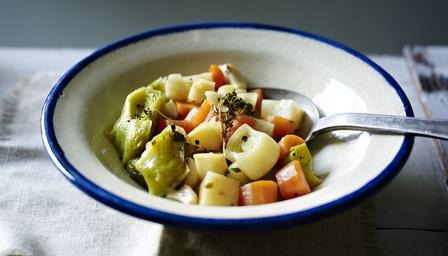Kohlrabi is a strange shaped vegetable with a curious name, to say the least. From the cabbage family it has a very sweet taste with a crunchy texture, some might say it’s similar to a turnip. You can find it in two different varieties, green or purple, being purple the most common of the two. It’s impressive how versatile it can be, from eaten raw, to boiled in a soup, mashed, roasted or even grated to make some fritters, it seems that we shouldn’t underestimate it. For more details and recipes about this interesting vegetable click here .
From BBC Good Food this recipes shows a simple way to cook kohlrabi but also a way of cooking vegetables that is quick and easy to prepare, a good resource when cooking your vegetables last minute.
Ingredients
- 3 leeks, trimmed and cut into 2cm/¾in lengths
- 2 kohlrabi (around 650g/1lb 7oz), trimmed, peeled and cut into 2cm/¾in cubes
- 3 large carrots (around 550g/1¼lb), peeled and cut into 2cm/¾in pieces
- 6 garlic cloves
- 1 bay leaf
- 2 sprigs fresh thyme
- water, to cover
- salt and freshly ground black pepper
- 40g/1½oz butter
Preparation method
- Place the leeks, kohlrabi, carrots and garlic into a wide shallow pan which will take them in a single layer. Tuck the herbs down among them.
- Pour in enough water to come about 1.5cm/½in up the sides of the pan. Season with salt and freshly ground black pepper and dot with butter.
- Bring up to the boil, then reduce the heat to the absolute minimum. Cover the pan with a lid or foil and leave to cook very gently for about an hour, stirring occasionally to make sure that it doesn’t catch. If necessary add an extra splash of water, or if it ends up too watery, uncover and boil the water off. Either way, you are aiming to end up with meltingly tender vegetables, perhaps slightly patched with brown towards the end of cooking, with little more than a few tablespoonfuls of syrupy liquid left in the pan. Serve warm.
Image and recipe from BBC Good Food
